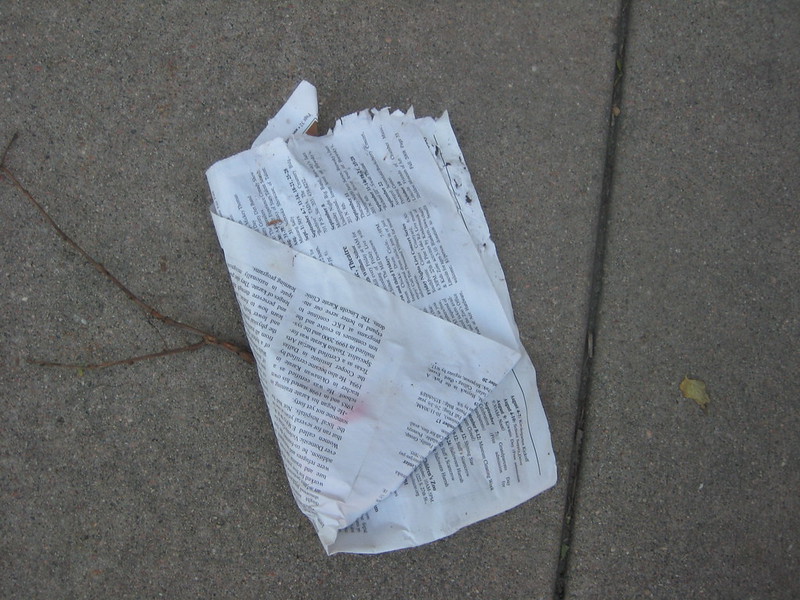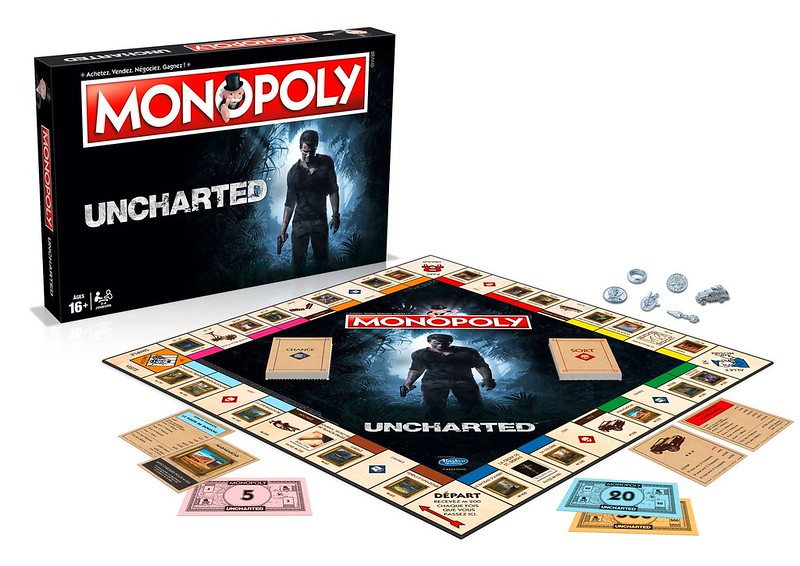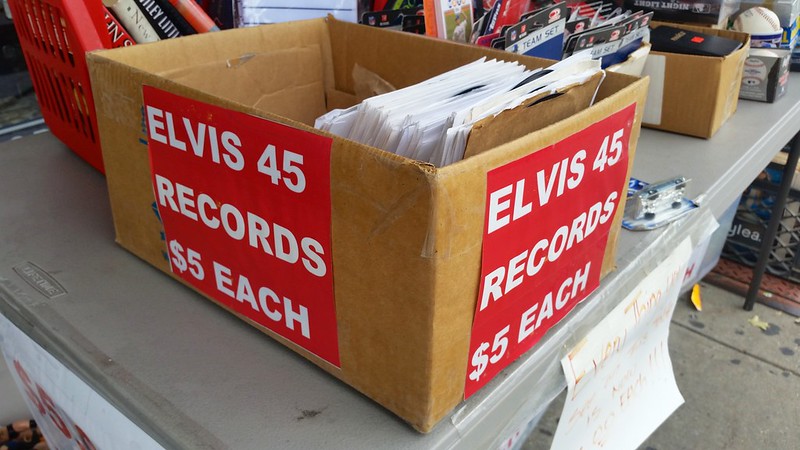Destroying Myths: related to Elvis Presley
All artists are the subject of many fake claims. Nevertheless, no one is surrounded by as many false information as Elvis Presley. It is quite an irony that the most you sell, the most your results are exaggerated. With the King, we meet people who do everything to maintain the myth, willingly lying to the general public.
The most famous example of that is Ernst Jorgensen who’s the responsible of Presley‘s catalog at Sony. To be fair, promoting the brand Elvis is his job. There is a lot of articles available making wild claims about his sales, articles well known by all his fans. Made by Nick Keene, Tony Galvin, Ernst Jorgensen himself, on multiple occasions, they all follow the same storyline to conclude the same thing: with 1 billion records sales Presley is the highest selling artist of all-time.
The structure of these articles is fairly clever. They present themselves as doubters, mention the “Mr Elvis” Jorgensen to be given more credit, then use accurate but unrepresentative data to imply fanciful conclusions and sustain the billion myth. Taken one by one, claims can hardly be contradicted since most are true. It all looks very credible so we are left believing their wild conclusions.
Today I’m going to deconstruct these data to see how, even if most of the raw data is valid, these statements are strictly false. That will enable you to adopt the appropriate critical mind when reading this kind of news to not be misled. Going through them we will also learn pretty much everything about Presley‘s RIAA certifications thanks to a whole bunch of detailed clarifications. Last but not least, we will prove that the catalog of Presley is now entirely up to date in terms of US awards.
Supposed lost sales documentation & excluded units
1956-1958 sales
We start this listing of inflation tricks with a classic one: lost documents. It’s definitely easy to argue a lot of receipts have been lost through the decades for an artist who debuted in 1955 and with so many records out there. If you add to that the incredible creativity of some fans, you reach improbable arguments. Below text from Tony Galvin:
There are areas where Elvis has lost sales that have been documented and this would also add to his overall total. For instance the RIAA came into being in late 1958 and all pre 59 sales for all artists have been excluded from the current listings. To my knowledge this situation still exists and the approximately five million album sales from 1956-58 that Elvis sold are not included in his RIAA certifications.
Big claims out there. It’s common knowledge that measures of the RIAA are retrospective and that pre-1959 are eligible for certifications. Presley‘s own second album, 1956’s Elvis, was certified Gold in February 1960. Back then, an album had to register an extensive run at the top to reach that criteria making it completely ludicrous to expect that a 4-years old album made it on the back of a few months of catalog sales only. Galvin tries to back up his claim:
RCA claimed that Elvis sold 2.75 million albums by the end of 1956 […] There were only two Elvis albums released in 1956 (ELVIS PRESLEY LPM 1254 & ELVIS LPM 1382) and between them they officially only have a gold award each. The official figures for these two albums were obviously understated and it is clear to me that these gold awards were based on post 1958 sales leaving nearly three million units out of the equation. Likewise early sales for LOVING YOU/ ELVIS GOLDEN RECORDS/ ELVIS XMAS ALBUM & KING CREOLE have been omitted from the RIAA certifications. That would bring another five million units into Elvis total sales.
In the first part of his article, Galvin pretends to have gone through Jorgensen’s book A Life In Music to check his sales figures. Surprisingly, he forgets the latter stated the debut album Elvis Presley sold 300,000 units in 1956 while Elvis was released just before the end of year. The figure of 2,75 million is clearly a singles equivalent value. As already stated multiple times through our various article, the norm from the 50s to the 80s was to state figures using singles as the basis, counting EPs as 2 units and albums as 6 units (some labels / media used 5). Presley‘s first two albums shipped approximately 450,000 units during 1956, concluding on 2,75 million once multiplied by 6. Gold awards of these albums, reached in 1966 and 1960 respectively, were thus all-inclusive. So were all sales of albums like Loving You, Christmas Album, etc. Just like that, the article invents 8 million sales from a period (1956-1958) were Presley‘s top albums were moving under half a million units during their promotional campaign. Please find below a receipt of Presley‘s worldwide album sales up to 1965:
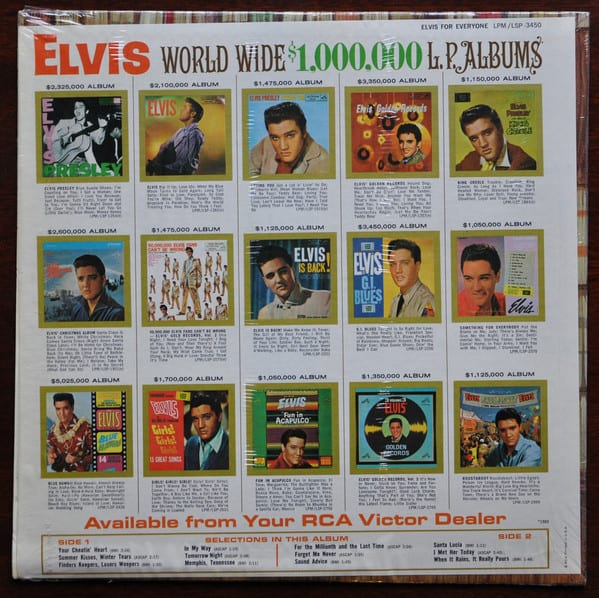
This is the back cover of the late 1965 LP Elvis For Everyone. The earlier albums were sold to consumers (the suggested list price) at $3,98 while dealers bought these units to RCA at around 65% of that price. Doing the math, albums issued from 1956 to 1958 sold 5,0 million by 1965, and that’s a worldwide figure.
Global figures stated as US ones
For example take the album GI BLUES, a platinum selling movie album only, but it sold 750,000 copies in it s first two months, 1.2 million copies by mid 1964 and it spent 111 weeks on the charts […] It is impossible in my mind to believe that this set in all it’s forms has not sold over two million copies, and probably much more […] To have not added a further half a million units over the next 35 years is inconceivable to me. There must have been a strong six figure sale for 1977 alone. I have been told but cannot confirm that one of the pressing plants contracted by RCA in 1977 to supply the massive demand for Elvis albums was the GREEN VALLEY RECORDS plant outside of Nashville Tennessee which had a capacity of 3000/5000 albums a day. This plant was supposed to have been contracted to produce only the GI BLUES album. For how long I do not know.
A clear case of wishful thinking taking over the reality. As we will see later in this article, these writings always claim Presley sold as much abroad than in the US. Conveniently, when data is reported for some albums, they act as if it was a US-only figure. Both numbers stated about G.I. Blues were global sales, as confirmed by the RCA receipt posted above. In the US, the album took two and a half years to reach Gold, which was worth over 650,000 units considering the dollar value requirements of the time. Bolded parts show the usual hyperboles we can read again and again in a lot of articles made by fans. It’s very important to be very careful when reading them.
Exclusion of reissues
More of the same, always from Galvin:
There is a similar story regarding new catalogue numbers as well as multiple formats for many of Elvis movie albums and I genuinely have difficulty believing that these albums have not managed to add an average of 100,000 odd sales in thirty years plus. If RCA/BMG kept these albums in continuous print for all that time they would have had to have sold less than 5000 copies a year to go over the gold mark
Thanks to Soundscan, we know that even the debut album Elvis Presley, arguably the most popular of his studio outputs, scanned only 108,000 from 1991 to 2010 under all its forms. Basically, 5,000 units a year is how much one of his top albums sold during the biggest era of the music industry with CD releases and remastered versions. Galvin is referring to soundtracks which have yet to go Gold, albums like Pot Luck and Fun in Acapulco. If the classic Elvis Presley can only sell 5,000 units a year, a realistic expectation would be under 1,000 units per year for these outdated items.
The pair of Brookville records
I mentioned the BROOKVILLE RECORDS TV advertised double album, ELVIS (DPL 2 0056) released in 1973 […] Launched at the time with the largest ever advertising budget in the history of the industry Stateside, it is widely believed to have been a winner for everybody with some claims of sales nearing ten million. The most conservative estimate I have seen is 3.5million […] BROOKVILLE RECORDS announced at the time of release that they were spending 3.5 million dollars on TV advertising a record for that time […] It is conceded by everybody that this set was a lucrative venture especially for RCA & BROOKVILLE and if this was the case the sales would have to have been well above the five million mark if not higher. I would base this assertion on the cost of manufacture, distribution, over the counter retail margin, license costs to RCA and the massive advertising budget. Based on a five dollar retail price BROOKVILLE would have had to sell over five million copies of the set to make a million dollars profit! […] The ROCKAWAY pressing plant in NEW JERSEY with a capacity of 60,000-80,000 albums a day was supposed to have exclusively concentrated on this album in the two months after Elvis died, according to BILLBOARD magazine.
I quote this large paragraph because it is the perfect example of implying fake figures while providing none. The advertising budget and the pressing plant capacity argument is something you will read in every Presley related article claiming a billion sales. It’s the perfect way to suggest massive sales while there is no evidence at all.
Once facts emerge they often tell a different story. This Brookville TV album titled Elvis from 1973 was certified 5xPlatinum in 2011 for 2,5 million sales, huge but nowhere near the 3,5-10 million ballpark claimed. The same goes to the second Brookville album, claimed to be on 2 million sales but certified for only 500,000 units sold. For the sake of accuracy, both albums did sell a more than their certified amount due to pricing issues – more on that over our next article – but still nowhere near to the 5-10 million claims.
A small step in Canada shows how these sales figures can be overstated:
I believe that this plant manufactured this album for the CANADIAN market as well as the US. Sales of MOODY BLUE in Canada were much higher than probably anywhere else in the world as a proportion of population, with over 800,000 copies sold there in the year after Elvis died.
In reality, the album Moody Blue went Platinum in October 1977 and 2xPlatinum in May 1978 in Canada. It appears Galvin isn’t aware of these official sources of information, instead relying on claims he read here and there through the years. It tells something key: always go by verified data before getting into dubious sources.
Record club sales
Another source for missing sales are the RCA & BMG RECORD CLUBS which are not to be under estimated as to their potential. Some specific releases from the RCA RECORD CLUB attained very substantial sales with for instance the club version of the WORLDWIDE GOLD AWARD HITS VOL 1 & 2 achieving platinum status
You read it well, “source for missing sales”. Trying to find “missing” sales isn’t the way to go. If we start arguing with similar arguments for all artists, it’s a highway for absurd inflation. In fact, Galvin contradicts himself while trying to support his claim. He goes on to say that albums can be issued in clubs only but still sell well, so well that they can reach Platinum. That’s absolutely true, but that also proves these albums are certified just like every other, thus they aren’t missing sales. As we will see, there have been Presley‘s records certified from virtually all relevant labels which leased his songs.
Leased products from 1973
Galvin isn’t the one looking for mysterious missing sales, Keene is just as creative:
For a start only a few scattered sales statistics exist for the period between March 1973 and January 1976,
Wow! This wild claim comes from the fact that Presley and his manager, Tom Parker, sold recordings’ rights to RCA in 1973. Some people don’t need more to argue sales receipts were lost. They back it with both Brookville and Pickwick releases that sold a lot of budget albums through the 70s without being certified. Jorgensen too mentioned them in 2001 while explaining why the RIAA tally of Presley isn’t higher:
- Brookville Record sales cannot at present be certified (7 x platinum – 2 albums)
- Another 5 to 7 million sales of Pickwick releases cannot be fully certified. Numbers are known, but they come from an audit report and not from actual sales accounting
We can clearly see that Keene, just like Galvin, was barely copying comments of Jorgensen who’s much more precise on his data. The point is: all Pickwick sales were certified in 2004. Their list below:
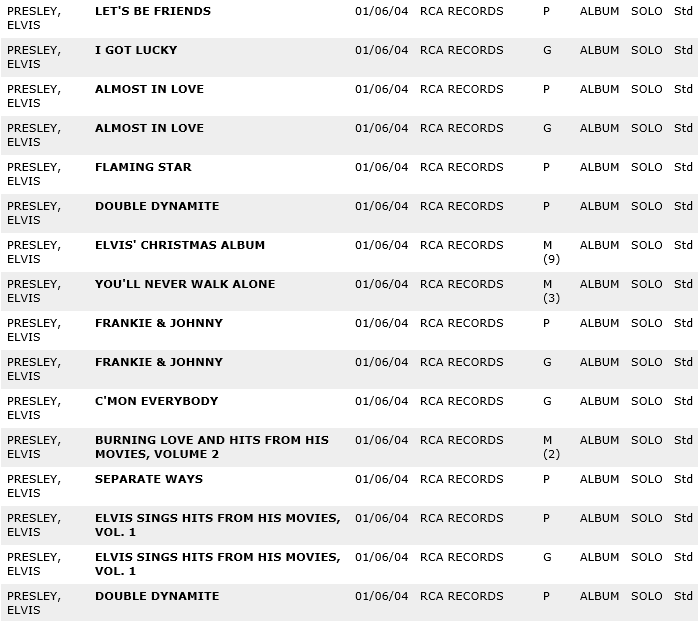
These albums were first issued by RCA / Camden but got licensed by Pickwick from 1973 to after the 1977 boost. Let’s have a quick overview at these famous Pickwick records:
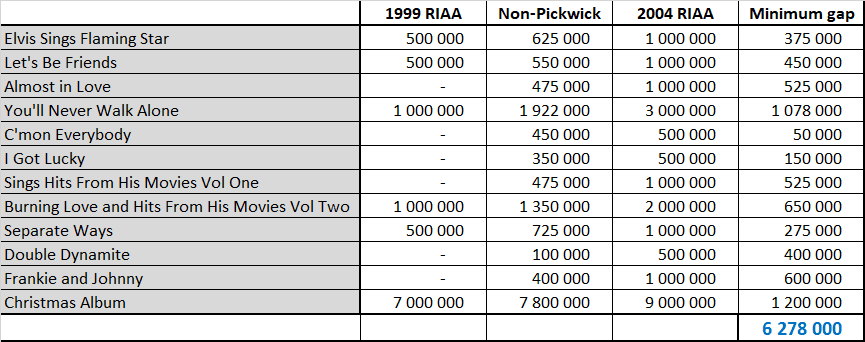
Non-Pickwick column contains quick guess estimates of standard versions’ sales by the end of the 90s. These numbers fit with previous RIAA certifications, with figures published by Jorgensen as well as Billboard charts and the organic appeal of their track lists.
We can see clearly that Jorgensen comment about 5 to 7 million sales of Pickwick releases which cannot be fully certified was correct when he made it in his 2001 interview. The issue is that they were audited in 2004, but people like Keene continued to add them on top of the updated RIAA total.
The unique case of Frankie & Johnny
Another interesting film album from the sales point of view is FRANKIE & JOHNNY (ACL 7007). I believe it was the 1976 PICKWICK re issue of the soundtrack that received the PLATINUM award and it is also my belief that the sales of the original album LPM 3553 (approx 350,000 initial sales) are being treated separately.
All fans of Presley who tried to study his sales had that same belief. Facts prove the opposite though. As previously shown, these Pickwick editions were audited in 2004. It’s convenient to argue that Frankie & Johnny original album wasn’t considered in that award since it never went Gold previously. As many as 6 other albums reissued by Pickwick were certified both before and after the inclusion of these editions, showing they have all been merged together so there is no reason to expect a different treatment for Frankie & Johnny, especially since 1 million Pickwick sales is clearly very, very optimistic as we will see later.
Uncharted, unscanned
Soundscan limits?
When valid sources contradict a fake claim, the only solution is to discredit them in order to sustain your point. Billboard Charts and Soundscan figures prove with no room for doubt that 600 million sales claims from the US are ludicrous, consequently arguments quickly popped up to argue they are inaccurate in the case of Presley.
Another question that comes up a lot in relation to Elvis sales is the lack of chart action […] If we claim massive sales why are there not the weeks of BILLBOARD chart sales to match them? The main reason I believe is that a great majority of Elvis sales have come from areas which are not part of the national US counting system run by SOUNDSCAN
Well, anyone realistic would understand that the main reason why many records haven’t chart well is because they have been selling poorly. There is the known exception of Country and Gospel recordings that had a specific panel, but they are certified correctly. Instead, they favor a scenario of an underground world where Presley albums are mostly unscanned.
Over the counter sales on a yearly basis as registered by chart shops on the SOUNDSCAN DATABASE average between 1.2 & 1.5 million. However the greatest source for Elvis CD sales are the shops outside Graceland which are not part of the system. Add to that the record clubs, sales through Elvis sites, official & unofficial, Christian book stores which are now a major outlet for Elvis product and the likes of TIMELIFE plus other leased packages. […] One could argue that Elvis would on a normal year sell three million CDs a year Stateside and with a package like the 30 NUMBER 1s, he would potentially double that tally
The fact that most releases by Presley appeared at least on minor Billboard rankings completely destroys this theory. Sales at Graceland, online and at book stores have been accounted for by Soundscan for many years. The strong correlation between soundscan figures and RIAA certifications for recent albums also confirms it. One may keep in mind that Soundscan is a sub-division of Nielsen which is a company scanning pretty much every bar code in the US, not only music related items. Unless a store provides you a bill that is manually written, chances are that your purchase is scanned by their system.
As for club sales, while they aren’t scanned, the situation is the same for all artists. In truth, they certainly impact Presley less than other artists since both BMG and Columbia House weren’t selling all his albums. Instead, they had only his most famous albums on their catalogs, albums that have been certified for these sales already.
Off the charts radar
The chart action of a particular album has no relevance to the amount it sells and this applies especially to Elvis and can be demonstrated time & time again. The AMAZING GRACE double Gospel CD is officially 2 x Platinum and is according to BMG nearing another gold certification yet it never went near the BILLBOARD HOT 100 ALBUM CHARTS. It has actually sold more than many of their number one albums. The same can be said for THE NUMBER ONE HITS which exploded onto the charts at the high position of 143 and promptly vanished yet again it managed to sell three million copies. The TOP THE HITS nearly broke into the HOT 100 reaching the dizzy heights of 117 but it still sold four million. There are dozens of examples when applied to Elvis and it proves that chart action or the lack of it does not factor into the sales equation.
Well, I’ll pass on the Hot 100 – BB200 confusion which shows that Galvin is hardly the dedicated charts expert he claims to be. No need to say either that Amazing Grace went 2xP for 1 million sales only and that you will hardly find 1994 #1 albums that sold less than this amount. It also did so at the peak of records clubs when double albums were selling a lot there thanks to their lower price on these expensive items.
In the introduction I mentioned the use of accurate but unrepresentative data to suggest fanciful conclusions, here is such a case. It’s known that Christian albums just like Latin ones were poorly tracked during the 90s. It’s also expected to see the leading hits packages for 15 years (from 1987 to 2002) of Presley sell in the multi-millions in spite of low peaks upon release. Nevertheless, to assume these releases are reflective of gigantic sales for all uncharted records is just a lie. They are the outliers, not the norm. It’s also no coincidence to see Galvin using two 2-CD packages that were thus double certified.
Pricing issues
The history of the 1970’s Christmas Album
This brings me on to another point made by the ESTATE in their statement explaining why they think Elvis is the greatest selling artist and this is the disqualification of certain albums because the wholesale trade price dropped below what the RIAA considered the acceptable norm for an album release. The Estate cited the 900,000 plus sales of THE ELVIS CHRISTMAS ALBUM (CAL 2428) as an example
Through their history, the RIAA had many price-related rules. Until 1974, certifications were quite simply based on dollar volume rather than units. Later on, a minimum price was still requested to prevent budget releases to shine over standard LPs. In this quote Galvin mentions an interesting point about the 1970 Christmas Album which had supposedly nearly 1 million sales unaccounted for because it was sold too cheaply. The certification history of this release is displayed below:

It’s important to understand these certifications to get the real mechanics behind Presley‘s US sales. The 1992 set of awards he received were traditional ones. Back then, club sales were mostly excluded and pricing rules were strict. The Christmas Album was under 2 million with this context. All club sales were made eligible in 1994. The album also reentered the Billboard Holiday Albums every year from 1991 to 1999. Both, club sales and ongoing catalog movements – close to 1 million units sold as per Soundscan – pushed it to an impressive 6xPlatinum award in the large audit of 1999.
Of course, it’s a golden opportunity to claim that certifications from 1992 were far from comprehensive. Once again though, the Christmas Album is the outlier. It was his only album that remained forever available on music clubs. If we check his remaining strong albums, they registered much more modest jumps after the eligibility of club sales was fully granted (Golden Records 1 from 5xP in 1992 to 6xP in 1999, How Great Thou Art, the 1957 Christmas Album all from 2xP in 1992 to 3xP in 1999).
RIAA certification batch from 2002
In mid 2002 the 1970 Christmas Album went 7xPlatinum. That awards campaign was made of two type of certifications. One type was about multi-discs sets, more on that later. Then there was albums which simply reached a new criteria thanks to ongoing sales. It was the case of Blue Hawaii for example, but also the Christmas Album. It made the Billboard Holiday Albums in late 1999, after the previous platinum disc, and continued to have residual sales during a few years although It’s Christmas Time had now replaced it. On top of that, its list price was $6,98 in CD, some $0,32 more per unit than the plateau of the RIAA. In concrete terms, it means that each 100,000 new sales were also rehabilitating 16,333 previously ineligible sales. From there, the LP wasn’t selling much anymore but still gained 3 more platinum discs!
We already explained that the batch of certifications from 2004 which was made possible by the addition of sales from Pickwick versions. That’s why the label mentioned for the Christmas Album is “RCA CAMDEN & PICKWICK”, because the award merges these versions together. Something we haven’t mention yet is that the price of these releases should have made them fall under the dollar volume criteria. It’s because before 2004 a more drastic change was operated at the RIAA.
The historical price criteria of the RIAA
In short, we are talking about the missing 900,000 sales mentioned by the Estate through Jorgensen for many years. In the past, it was necessary to reach both the unit criteria and the revenue criteria. These criteria were as below for each platinum disc:
Quantity:
One million units. Manufacturer’s dollar volume at least $2 million based on 33 1/3% of sugg. list price
The problem is that the 1970 Christmas Album was a budget release from day 1 and sold plenty of copies thanks to clubs free goods. Thus, even if RCA were able to prove 10 million units sold, the album hadn’t gross $20 million based on a third of suggested list price.
This exclusion of some units due to low gross numbers was confirmed by Jorgensen in his interview from 2001:
2. The ongoing modifications that the RIAA has made to adjust to new sales conditions and trends, include a number of different pricing parameters, that eliminate or reduce a substantial number of Elvis sales – including the dismissal of more than 1 million units of Elvis’ Christmas Album from 1970.
No more price threshold for deed catalog albums
In the middle of his fight for the throne against the Liberty label / Garth Brooks, Jorgensen managed to get rid of this rule from the RIAA. Right now, we can read the below text at the RIAA:
Catalog product, specifically pre-1972 album releases, are eligible for certification by meeting either the unit shipment or manufacturer’s dollar requirement for each award level. The purpose of this rule is to make certain exceptions for older albums that have very little supporting documentation substantiating that they meet both the unit requirement and the dollar requirement. Without the rule, these titles would potentially be unable to meet the dollar requirement based on the limited documentation available from sales that occurred decades ago.
To be exact, the RIAA removed the pricing threshold for pre-1972 albums in 2003. That update led to a massive flow of new Presley‘s certifications. It’s one more evidence that RCA can perfectly play the RIAA game. Thanks to these facts, we know that all pre-1972 Presley albums had 100% of their sales eligible in 2004. A quick overview of these certifications suggest the catalog wasn’t audited in full until 2011 though. In fact, 14 out of the 17 awards from 2004 were Pickwick-related while the remaining 3 were relatively recent releases, first issued in 1987-1993. Deep catalog items got upgraded at last with their full units in 2011, an upgrade which brought very interesting elements.
2011, the comprehensive update
Instantly, we know that each 1956-1971 album was up to date in 2011 when these awards occurred. In that case, since we know why they happened, we have one more priceless information: remaining 1956-1971 also had possibly ineligible units in their previous awards due to pricing issues. Even if they weren’t able to reach a new plateau thanks to the new RIAA, it means at least that they weren’t just over their award level.
Not all will be concerned. We have to wonder which albums had the lowest average revenue in their lifetime to see which ones got units excluded by former RIAA restrictions. The oldest albums, issued when the price was low, budget releases as well as good catalog sellers that moved into budget lines were hot contenders to have ineligible sales until 2011. To clarify this situation, let’s have a look at albums that were updated at that date.
Box sets of original albums enter the equation
Both 1956’s albums, Elvis Presley and Elvis, jumped to Platinum. It had to be expected as the suggested list price back then was only $3,98 for standard LPs. These awards are interesting for two reasons. First because they came one month before the larger audit of September 2011. Second because they were both certified at the same time, in August 10, 2010. The Legacy Edition which contained both sets together, issued on September 27, 2010, pushed both of them ahead of the million mark. The fact that the set wasn’t available for consumers until a month later doesn’t matter: as soon as a record is available for retailers to order, sales start to kick in.
How Great Thou Art was also updated in October 13, 2010 to 3xPlatinum. It was the only album certified at that date. Since it sold very well through the years, when the suggested list price was high enough to see dollar volume match units sold, it wasn’t due to the end of the price limit. Instead, the album moved past 3 million thanks to the Follow that Dream reissue that came out 3 months earlier. Obviously, it’s no coincidence that all these stand-alone certifications happened around the same time of new editions.
Then, none of his 25 LPs from 1957 to 1966 were updated in 2010/2011. Through these years the Stereo LP boomed. It was priced $1 higher than Mono recordings. Added to sales from later years and more expensive editions, their sales weren’t impacted by former dollar volume rules. An LP had possibly sales excluded on its last award still: the 1957 Elvis’ Christmas Album.
More suggested list price stories
The former was released at $3,98 and the price remained the same for several years. The CD reissue from 1985 had a suggested list price of $8,98 though. If we simplify the problem saying that only these two versions ever existed, the album needed more than 3 million units to hit 3xPlatinum in 1999 as soon as the CD represented less than 40,4% of its sales. Had the CD accounted for 20% of its total sales, then the album needed 3,614,000 units to be 3xPlatinum. Of course, the stereo version as well as 70s reissues mean the average price through years was higher, but there is still a possibility that the set was under $6 million in revenue went it reached 3 million units. What’s safe to say is that it remains under 4 million units since it hasn’t been upgraded since the end of this restrictive rule for pre-1972 albums.
We can also raise a point about His Hand In Mine, although it’s known that it is well over its 1 million units certified since the booklet of his recent reissue pointed out 1,5 million units sold – although there is no reference to that figure being a US-only one.
One pair of albums updated after 2011 because of the change of rules is Elvis In Person and That’s the Way It Is, two live sets from 1970. The date is important. The former was a reissue of the first LP from 1969’s package From Memphis to Vegas / From Vegas to Memphis. It explains why it completely failed to enter the Billboard 200 Album Chart. it also means nearly all its sales came as catalog, on average at a cheap price. The latter album sold well during the Christmas season of 1970, just before the increase in LP price by RCA from $4,98 to $5,98. It’s interesting because a third of that list price is roughly $2 which falls in line with the 1 million units / $2 million revenue criteria set by the RIAA. That’s why the pricing rule was removed only for pre-1972 albums, because from there the price was high enough to automatically grant both criteria were met if the units criteria was reached. This rules out the possibility of missing sales for albums released by RCA from March 1971.
The case of Camden budget albums
There is still one exception, releases from the budget line RCA Camden, the famous ones which were recertified in 2004 thanks to the addition of Pickwick units. Let’s check back their list:

You may remind that Jorgensen stated Pickwick sales amounted for 5 to 7 million units. Here we illustrated 6,3 million sales by sticking to the minimum gap with the newly certified amount. All these albums had obviously sold more. In fact, I Got Lucky went Platinum ultimately and an album like C’mon Everybody is no doubt much higher than 50,000 sales through Pickwick. If we add an average of 300,000 units on top of the certified amount, we reach nearly 10 million Pickwick sales, outside of the ballpark provided by Jorgensen who saws these receipts. What happened there?
On that table, I had purposely ignored pricing issues, I also included Double Dynamite while unlike others, it wasn’t released by RCA at first while Jorgensen was speaking about his catalog. I did these mistakes to point out how tricky it is to dig into such a catalog and how careful we should be. Now we will see an improved table that also includes estimated units that were previously excluded by the RIAA:

The point is that the former “Non-Pickwick” column includes estimates as per RIAA data which back in 1999 had these pricing rules in practice. With a list price of $1,89 it would take a massive 9,524,000 units for You’ll Never Walk Alone to be certified 3xPlatinum. But then, why hasn’t it gone 9xPlatinum after the pricing rule was removed for pre-1972 albums? We need to consider the suggested list price that matters is the average of its lifetime. The price of Camden records was increased to $2,98 the week of You’ll Never Walk Alone release and it concerned that LP. At that price, it would take 6,040,000 units to be awarded 3xPlatinum. Cassettes and 8-tracks, representing about 15% of the market, were sold at $4,98. These albums also sold a lot of units from 1973 to the 80s at Pickwick, with list prices being already much higher, reaching $5,98 by the end of this period. By the time the album was first issued in CD in 1987, the price was already on $8,98.
This evolution of price explains why even an album that had all its sales under budget lines like the 1970 Christmas Album only had roughly 10% of its units unaccounted for. It’s also true for an album like You’ll Never Walk Alone which sold well through the years. For an album like I Got Lucky yet, with very low catalog appeal, a larger share of its units were shifted early when the price was still low. That’s why it went from uncertified in 1999 to Platinum in 2011.
Post-1972 albums
You possibly noticed that I highlighted in blue 3 albums from the Camden list. These records were issued after 1972 so pricing rules still apply for them. They are the two Hits From His Movies volumes as well as Separate Ways. As of now, they all likely have a decent share of sales that can’t be accounted for, although they wouldn’t be enough to bring them to higher criteria even if they were made eligible. Of course, for each new sale they may achieve today, that will rehabilitate formerly excluded sales.
A good example of that situation is Frankie & Johnny, released through Follow that Dream in 2003. With a list price of $33,64, each 10,000 units sold gross enough extra dollars to validate 46,062 sales formerly excluded. This dynamic also explains the 2011 award of Mahalo from Elvis. A few sales through iTunes or from imports Amazon – that will be proportionally high for an album unavailable at retail for very long – have been enough to request a Gold award for this 1978 record formerly released by Pickwick at budget price.
Additional exclusion rules
Multi-discs albums
Chart experts tend to exclude extra sales obtained thanks to multi-discs sets in order to identify the true number of albums purchased. Keene went the other way, trying to look at multi-discs sets that could reach higher certifications.
A number of double albums were counted as one album by the RIAA because of their playing time. But they were physically distributed as two albums and priced accordingly so Sony BMG are justifiably entitled to count them as such.
His source isn’t hard to identify since it’s once again Jorgensen who stated in 2001:
This again hurts Elvis, as the limit is 100 minutes, and a double album in the days of vinyl records could not hold 100 minutes with sacrificing the sound. This means that classic Presley albums like Aloha from Hawaii and Elvis in Concert only count as single albums.
What is this about? You must be aware that the RIAA counts every disc as a sale so a 1-million selling double album will be certified 2xPlatinum. That rule is applied under defined parameters. Until 1975, there was no criteria based on units sold but instead a gross to reach so double album were implicitly weighted higher since they were more expensive. Many years later when the units criteria was already the norm, to remain consistent, they remained consistent with that logic by allowing each disc from a set to be certified. During the 90s, the RIAA requested to double albums to be at least 100 minutes long considering the content a CD could contain. Presley issued various 2xLP that were much shorter yet simply because the LP can’t contain as much music as a CD.
Misunderstood awards of Aloha from Hawaii and Elvis in Concert
In fact, CD reissues of albums like Aloha from Hawaii Via Satellite and Elvis In Concert were 1-CD issues only against the original 2xLPs. That’s why they were certified as 1-disc albums up to 1999:

The suggested list price of Aloha from Hawaii was $7,98 during its initial years. Since there was no criteria based on units sold back then but only $1 million to make based on a third of that price, the album went Gold quickly thanks to 376,000 units shipped. In 1988 the units rule was in place, so it had sold 2 million copies by then. It was released in CD in 1992 but its major promotional push as a catalog item came in 1998 when the 25th anniversary CD album came out. This release sold roughly 650,000 units to date in the US.
In 1999, thanks to both the new eligibility of clubs free goods and the large shipments of the 1998 edition, the set reached 3xPlatinum for 3 million sales. With a running time of 85 minutes, it wasn’t possible to certify it as a double album. In any case, since its initial price was what was called a Medium price rather than a double price, it wouldn’t have been able to be certified 6xPlatinum anyway. If we assume 2,5 million LPs sold by then at $7,98 plus 500,000 CDs at $12,98, that represents a volume of $8,8 million, only good enough for 4xPlatinum.
Just like the pricing rule was discontinued for pre-1972 albums in early 00s, they also adjusted requested parameters for multi-discs LPs, discontinuing the running time limit for pre-1982 album, the year of the CD arrival. Thanks to this new rule, our two Presley albums of interest were at last certified as double LPs for the first time in 2002:

The same was true for This is Elvis, a 1981 double album that went Gold on that 2002 update thanks to 250,000 units shipped. A lot of people misunderstood that update, believing they were still certified as single albums because of the former Jorgensen comments. Keene stated in 2008:
the 1973 ‘Aloha’ album which has certified sales of 5 million but as it is or was a double album has therefore sold 10 million units. However its running time is below RIAA rules so they count it as a single album
Since Aloha hasn’t gone 6xPlatinum but only 5xPlatinum, they though it still hadn’t been doubled. The RIAA doesn’t simply multiply by two shipped units though. They certify how many discs have really been sold. Thus, CD units sold since 1992 are counted as 1, the 2-units rule is only valid for former LPs. If we go back to our previous assumption, 2,5 million LPs (x2) plus 500,000 CDs (x1) mean 5,5 million units have been sold rather than 6 million plus.
Over-interpretation of the 100-minutes rule
The case of Aloha led many people to believe that RIAA’s parameters enabled only the number of CDs a reissue included to be certified, no matter how many LP the original release had. The truth is that the running time limit was also 100 minutes for packs of 3 or more discs, even for post-1982 releases. A good example is the box of Reader’s Digest, Elvis! His Greatest Hits. A 7xLP upon release in 1979, its running time was short for a 7-discs set but still well over 100 minutes. It means its 1998 Platinum award involved each of its discs so it only had to ship 142,857 units as long as the price criteria was met.
Similarly, the 4xLP / 2xCD set The Other Sides – Worldwide Gold Award Hits, Vol. 2 went Gold in 1999. As it was 118:20 minutes long, it was eligible for multi-discs certifications during the 90s already. Only available through a limited release in CD, most of its copies were sold in LP format, so that award represented 125,000 units shipped. The story is the same for box sets Worldwide 50 Gold Award Hits Vol One (4xLP, 2xPlatinum for 500,000 units) and Elvis Aaron Presley (8xLP, Platinum for 125,000 units), both over 100 minutes long.
The mathematical side of things
It’s basically the favorite argument of people trying to prove that Presley moved 1 billion records: adding a nice mathematical average of units to every record for sales below/above/between certification levels. At half a million units a piece for 400+ releases, you can quickly add insane amounts. The issue is that these calculations are largely manipulated in order to falsify totals, we will review how it is done and which formulas we can set to obtain more realistic results.
Sales below/above/between certification levels
Jorgensen himself likes to play the game of the mathematical mean. Here is how he applied it:
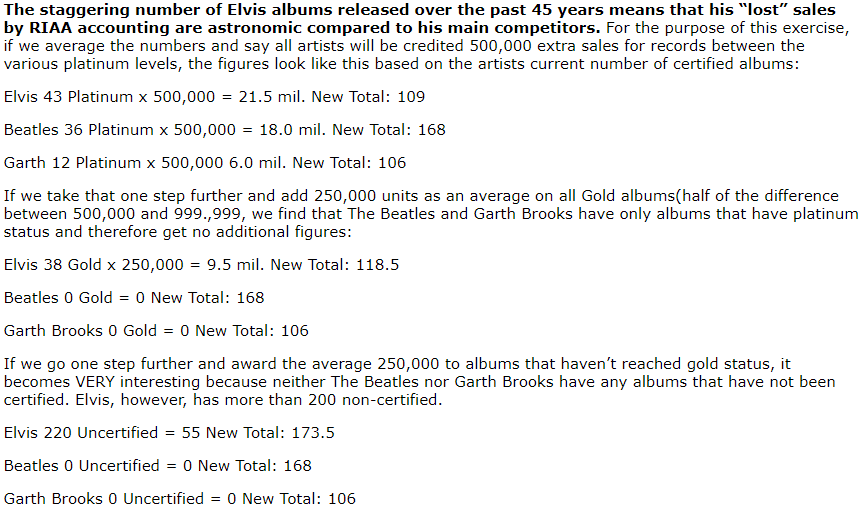
Please notice figures are from 2001. Adding 500,000 units for albums between million thresholds and 250,000 units for albums between 500,000 units levels sounds fair. It is hugely incorrect mathematically speaking though. In fact, that would make sense if each and every purchase was independent. Fact is, the most people purchase a record, the harder it is for that record to continue to amass buyers quite simply because the share of its target audience which already owns it increases. An album up to 3 million units will have a much harder time getting 1 million more buyers than a fresh new record that nobody owns. This is very visible on Presley‘s statistics. I’ll use 400 total US albums because of the influx of new releases during the last two decades but to illustrate our point that number doesn’t really matter.
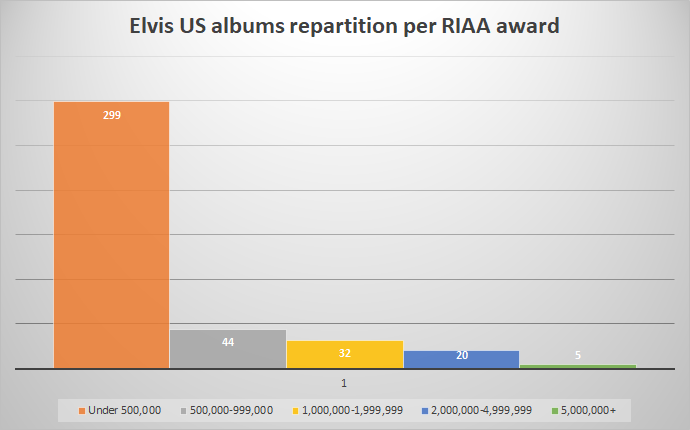
This graphic shows that the higher you climb, the least albums there is. Thus, mathematics tell the same is true inside each area. For example, among the 32 albums sitting between 1 million and 2 million, the larger part may be between 1 million and 1,5 million – in fact, after studying most of them, as few as 3 seem to be over 1,5 million, but let’s stick to mathematical concerns for now.
You may notice the graphic is misleading. In fact, ballparks do not use the same size. There is 44 albums inside a 500,000 units area while 32 stand inside a 1 million units area, and so on. A better representation is displayed below:
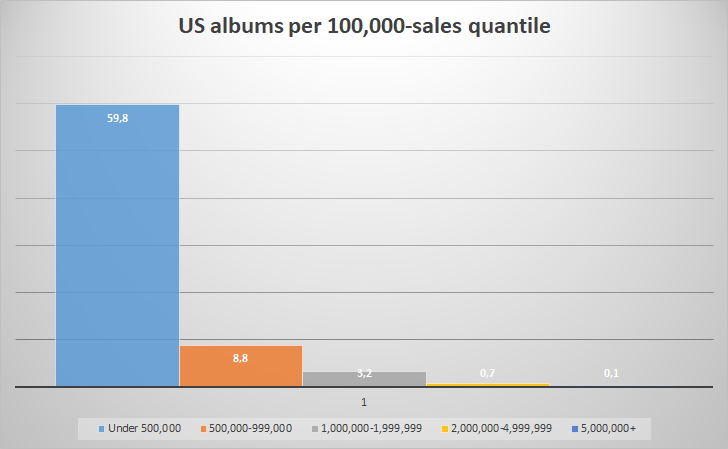
What does this mean? Among Presley‘s albums, there is 8,8 albums every 100,000 units span inside the Gold level (from 500,000 to 999,000), but only 3,2 albums every 100,000 units span inside the Platinum level. It confirms our previous comment: at each criteria, there will be more records sitting just over the mark than just under the next one.
To highlight how it impacts results, below is a dispatch of the 32 Platinum discs through all 100,000 units quantiles following a linear decrease as shown by the previous graphic. Keep in mind this is a mathematical model rather than an example of a real case so the number of albums includes floats, what’s important is that the decrease is linear and that the total is 32.
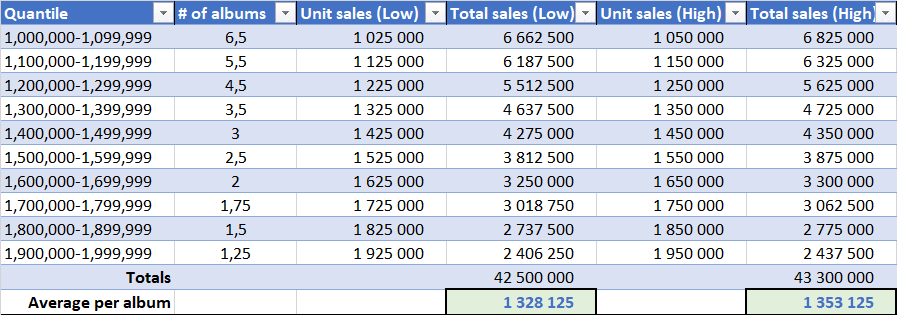
Even assuming mid-range sales for each album (the “High” columns), these albums appear to have an expected mean at 1,35 million only rather than 1,5 million. Since the linear decrease of occurrences also happen inside each quantile, I added a “Low” case where we suppose sales are at a 1/4th of the quantile. Final results don’t change that much since they sit at 1,33 million.
We showed that the true mean of sales in-between certification criteria is around 34% instead of 50%. This is a mathematical point of view. Consequently doesn’t consider that some of the albums close to the next level have been pushed to it thanks to reissues like Elvis Presley, Elvis and How Great Thou Art. That situation decreases the real mean. Here, we will stick with the mathematical average still. Naturally, we wonder how large is the impact of that 34% mean instead of 50% over a discography like the one of Presley.
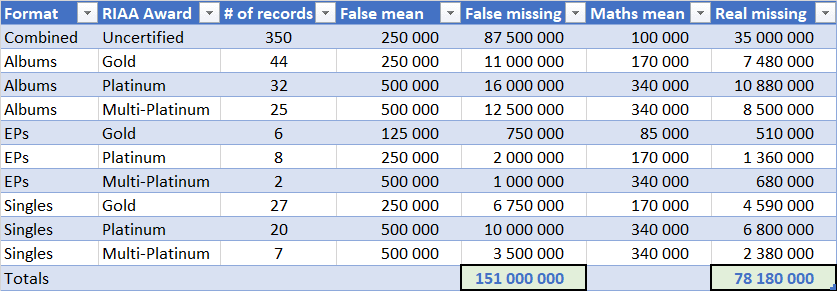
I manually fixed a mean of 100,000 for uncertified records. We know that it is much lower than 170,000 since it is the one for 500,000-999,000 albums. Uncertified albums include a lot of minor releases, limited albums and plenty of multi-discs that haven’t been certified Gold still. You may change it to a lower or higher value, it doesn’t change the final view.
Indeed, results provide a striking conclusion: the artificial mean set mid-way to the next level of awards nearly doubles a realistic calculation. From 78 million to 151 million. Believe it or not, that’s only one of the 3 major issues with these calculations…
Certification levels are different for multi-discs sets
It’s amusing to see that people who check in detail RIAA rules in order to find missing sales completely ignore an issue as massive as this one: the mathematical mean of uncertified sales is different for multi-discs sets.
A million selling double album will be certified 2xPlatinum. If we assume it has 500,000 units unaccounted for, we are basically saying it is eligible for 3xPlatinum! We can hardly talk about an average when we are assuming it sold the maximum possible. Of course, it gets only worst for 3/4+ discs packages who get awarded a mean which tops higher certification levels. It’s no small detail, out of Presley‘s 101 album certifications, as many as 31 involve multi-discs calculations. Below are results factoring in multi-discs:

While I mention albums because we know which ones are multi-discs or not, the issue also impacts singles since 12″ and maxi singles are also double-certified. They weren’t there when Presley peaked, but a lot of his reissues included these formats. Of course, we may try to adjust mathematical assumptions and get 42, 44, 48 or 50 million missing sales instead of 46 million. What’s clear is that we will never reach the ludicrous figure of 114,5 million that we get while applying Jorgensen’s method.
Massive double-counting
Throughout this article you saw that there is two ways to value the US catalog of Presley. The first way is to go through every release, all labels, pricing issues, etc, to find as much information as possible about all records. The second way is to set up a simple mathematical problem and go with that. Various fans, including Keene, went by a third way: they added together sales from both methods! More: they also added millions of sales for already certified material, ultimately tripling numbers. Keene got the following totals:

Please keep in mind that his figures are aimed to be all-inclusive in terms of formats.
He starts by adding a mysterious 10 million sales “awaiting RIAA certification”. We will pass on this dubious inflation method. Then 115 million are added for sales below/above/between certifications levels. As we identified, the real number is much lower.
A massive 45 million folder is added for “Sun / RCA / Pickwick”. First, the Sun records. They refer to a handful of singles Presley issued before signing for RCA in November 1955. They all failed to enter the Hot 100 and would only add residual sales that already fall under “sales below minimum certification levels” anyway. Second, he targets “RCA” missing sales pointing out at supposedly lost 1973-1976 documentation. As we can see with RIAA certifications for albums issued at that time, their audit are clearly complete. Third, Pickwick units. The issue is that they were already certified in 2008 since they were audited in 2004. This entire 45 million folder is thus a pure invention.
The category *** is detailed with double albums that were certified as single albums because of the running time – he points out Aloha – and pricing limits. We went through these disqualified sales too, showing they were both allowed in 2002 and 2004 batches of awards, respectively. That’s 20 million sales added for units already accounted for into the 170 million tally of the RIAA.
The last “others” block is justified with releases by the likes Time Life, Reader’s Digest, Camden, etc. The problem once again is that these releases were already certified by the RIAA by 2008. The ones which weren’t have already been supposedly accounted for under the “sales below minimum certification levels” category. The only true missing sales by 2008 were both Brookville releases that were at last awarded in 2010, but they got a combined 6 Platinum discs (for 3 million sales) rather than 40 (!) million.
As a consequence, from 3 million legitimate sales missing, the article adds 10+45+20+40 = 115 million sales, on top of the 115 million calculated which is itself massively overstated by over 35 million (from 78 million to 115 million) even allowing multi-discs units.
This round of monster duplicated counting happens in almost all Elvis-related sales breakdowns. That’s how they can reach 400 million units by 2008 while the current reality is much lower. An updated disc count would be 197 million RIAA certified sales plus 78 million units as per mathematical mean additions, a comprehensive tally of 275 million. Taking off extra units from multi-discs, we are left with close to 173 million RIAA certified sales plus over 67 million additions calculated, a final total of 240 million records sold.
International sales
Convenient ratio
Most people digging into Presley‘s discography seem to lose steam after completing his US statistics, ending with highly questionable and gross statements for his sales abroad. The point is that his awards’ achievements are much less impressive abroad than in the US, plus remaining markets used to be much weaker with awfully low criteria. Sales totals from France, Germany, Brazil or so would look terribly unimpressive in comparison to his US numbers, putting a huge shade of doubt over the billion-ish claims. Thus, instead of reviewing his results abroad, they always go by wild US-World ratios that are backed by nothing.
Here is Galvin claim:
Even allowing for one hundred million sold in the year after Elvis died I m inclined to believe a figure of 300 to 350 million sales are far more realistic. While it is generally held that the US is responsible for two thirds of all Elvis sales I believe that the opposite is really the case. The figures that I have seen both reliable as well as speculative seem to indicate that sales outside of the US since the early eighties have been on a higher level and that brings me to believe that Elvis total world sales (albums only) are between six & seven hundred million.
He claims 300-350 million US sales which represent 1/3 (!) of his sales, implying a billion total records sales globally. What’s the take of Keene on that after his 400-million claim for the US?
All this evidence seems to point towards an overall international sales figure that at the very least now represents over 60 % of total global sales to date i.e. a minimum of 600 million copies or units once the US figure is duly adjusted.
We will see later on that the “evidences” he points out are just as false as his claims for US sales. His personal bet is set on 600 million (!) sales overseas on top of 400 million in the US, hitting 1 billion globally.
We wonder what Jorgensen, an RCA executive, has to say about that. In 2006 he stated:
It is estimated that Elvis has sold over 600 million units in the USA and over 400 million units in all other countries combined for a total of over one billion units sold worldwide.
Conveniently, while no one provides receipts for foreign sales and while they all have different figures for the US, they all add just enough to make it a billion worldwide! Please also notice that while Galvin and Keene largely acknowledge Jorgensen, they don’t hesitate to inflate even more that 400 million abroad sales claim to reach a billion.
Let’s also highlight that US sales of all Galvin, Keene and Jorgensen were massively inflated with millions of sales duplicated. These duplicated units are once again multiplied since they are extrapolated into international sales! A 40-60 ratio based on 250 million US sales instead of 400 million would conclude on 625 million, no doubt much less flashy than 1 billion. Had one of them conclude on 250 million US sales yet, chances are an argument would have been made to claim a 25-75 US-abroad sales ratio!
No official confirmation
One thing even more important to notice: Jorgensen does not commit himself on that claim. He is suiting his marketer costume, stating “it is estimated that…”. Estimated by who? How? It’s how you imply a claim without actually making it. That’s definitely clever marketing as most people won’t need more to repeat it as an absolute truth. In his second interview, from 2001, he already used the same tricks:
Elvis Information Network: Several people have claimed that the 1 billion sales figure for Elvis (and The Beatles) is based on each sale of an album being multiplied by the number of its tracks. Obviously, using this argument makes it much easier to justify a 1 billion claim. What can you tell us about this in the context of BMG’s claim that Elvis has sold more than 1 billion records & CDs?
Ernst Jorgensen: The claim was historically made by somebody else, before I was involved. I have only a vague, and not supportive idea of how they reached that number. It wasn’t by doing the above multiplication – if so, the number would be staggering (for both Beatles and Elvis)
He starts by clearly stepping out from making the famous billion sales claim. As an executive, claiming it would imply paying Presley‘s estate the due royalties about 1 billion sales even if actual sales are much lower. He continues to use his intelligence saying the total wasn’t reached “doing the above multiplication”. Indeed, it wasn’t done by multiplying album sales “by the number of its tracks”, but instead by 6. Jorgensen says nothing that is strictly false, but he voluntarily lets the reader believing something that is completely wrong. The Elvis Information Network insisted on that subject:
Elvis Information Network: The figure of 1 billion has been around for a long time now. What is BMG’s official position in 2006 on how many records & CDs Elvis has sold worldwide?
Ernst Jorgensen: I don’t know if BMG wants to have an official position on this, but I believe that 1 billion is quite likely.
Once again he goes with an “I believe that”, “is likely” after taking off his BMG executive suits. It’s as clear as water that he doesn’t want to commit on that claim since he knows it is simply wrong. The following exchanges confirm this situation:
Elvis Information Network: What is your view on once and for all “proving” the 1 billion sales claim?
Ernst Jorgensen: I think “proving” it is very unlikely. We would never be able to find substantial “new” evidence. Since we are SONY/BMG and NOT RCA Records, we only have what we inherited on buying the company in 1986. So please don’t blame it on us!!!! (ha!!)
Elvis Information Network: Since BMG bought RCA we assume there are much more detailed sales figures, at least from the late 1980s to today. Are you able to tell us how many units Elvis has sold globally since BMG acquired RCA?
Ernst Jorgensen: “We don’t make those type of comments”, these are basically “company private”. However we are always happy to report new RIAA awards.
The most global album
Jorgensen continues to suggest fake numbers on the back of unrepresentative examples. Below his statement about US/World sales:
Elvis Information Network: What percentage of these sales relate to North America ?
Ernst Jorgensen: On a normal release (“30 Number 1 Hits” as an example), total sales are 1/3 from the U.S. and 2/3 from the rest of the world.
It’s known for long that 30 #1 Hits was a global smash issued at the peak of the market in a lot of historically weak markets. It is a normal release for a label indeed, but absolutely not representative of Presley‘s sales distribution through the World. Jorgensen uses it precisely because it was his largest seller ever abroad. In the second interview, when he pointed out that “it is estimated that…” he went with 60/40 repartition, way off from this 33/67 claim that he knows to be strictly false. For reference purpose, shipments of 30 #1 Hits leaked around the same time of that interview, showing global sales of 10,072,940 units including 4,205,405 from the US. His most global release still shifted 41,75% of its units stateside rather than 33%.
These approximations and inconsistencies aren’t rare in his interviews. As a manager, his target is to promote Presley, not to provide accurate receipts. One more example is when he is challenged about sales of that 2002 compilation:
EIN: […] Is it fair to say that, as happened by the early 1990s, sales of recycled Elvis product are generally declining?
EJ: Over 12 million sold of “Elvis 30 Number 1 Hits”! If you talk about sales of original albums, they were never the best selling records.
EIN: […] Elvis was never a seller of albums on the scale of The Beatles, The Eagles, Garth Brooks or Michael Jackson (at his peak). Doesn’t this suggest there are more record buying fans of these artists than Elvis?
EJ: […] Secondly, the sales potential of music definitely has obviously escalated in recent decades. Elvis’ first album became RCA’s all-time bestseller in 1956 by selling 300,000 copies. We have had an album selling 10-12 million from just a few years ago to now. […]
EIN: The last “official” figure we saw had global sales of 30 #1’s around 10 million. So it is now globally 12 million?
EJ: I haven’t checked the number recently.
I feel like I have to be fair with Jorgensen. As an accuracy-obsessed person, I can’t help feeling my intelligence is being mocked when I read his statements full of false implicit meanings. As the responsible of Presley‘s catalog though, he is doing a wonderful job and his posture in front of media is pretty natural giving his role. He has also been key in lobbying to update the appropriate RIAA rules. His interviews are still worth reading. On top of some concrete and valuable examples he provides, he understands the mechanics of buyers and explains it well.
The outlier’s lack of representativeness
Surprisingly, or not, Keene uses exactly the same example to justify his 40-60 claim. The difference is that he does it with massively flawed data:
Sony BMG claim sales of the 2002 album ‘ELV1S 30 #1 Hits’ have now topped the 16 million mark – with a good 12 million of those sold outside the States
Please notice how he attributes the 16 million figure to Sony BMG – who in truth never claimed this fanciful figure. I can only advice one more time to be very careful with online claims arguing it is an official report from the label. More often than not, they are made up claims. This false figure enables Keene to claim only 25% of 30 #1 Hits sales come from the US when the truth is near 42%. He keeps going with similarly inaccurate data about Moody Blue:
‘Moody Blue’ was by 1982 thought to be one of the King’s top sellers with global sales put at more than 14 million copies. However once US exports to Canada are excluded and ignoring any ‘lost’ sales factor since that is pure guesswork then it would seem that less than 3 million of those were actually sold to the home market
Up to date sales of Moody Blue stand on 4 million something, nowhere near the 14 million up to 1982 claimed here. Obviously, it completely changes the US-overseas split. In terms of representativeness the usage of Moody Blue is also disastrous since Presley‘s passing made it a global event which wasn’t the case for his previous albums. It was his very first Gold album in France, his first charting LP in Italy and his biggest studio album to date in most international markets.
One more ‘evidence’ suggested by Keene to claim a high share of sales from elsewhere is records never released in the home market:
Those singles which were NEVER released in the States, but were huge hits in a wide range of countries overseas, including amongst others ‘A Mess of Blues’ (1960), ‘Wooden Heart’ (1961), ‘I Just Can’t Help Believing’ (1971) and ‘The Girl of My Best Friend’ (1976).
It’s true that these songs weren’t issued as singles in the US. This argument completely backfires into Keene though. In fact, Presley charted 139 singles in the US. Except in the UK, he came nowhere near to this number elsewhere. In concrete words, for every international hit that wasn’t released in the US there have been much more US hits that haven’t been released internationally. Keene further argues:
The exception to the picture I have painted is Presley’s gospel music which continues to find particular favour with the strong Christian movement in the States and has no parallel elsewhere.
Here the issue is that this supposed exception was more like the norm back in the day. The argument of Keene for gospel recordings is just as true for early singles, country LPs, original studio albums, Christmas releases and collectors items. To resume, abroad Presley has been big with his hits compilations, while his spectrum of success was much, much larger in the US.
Conclusion
It’s often the first step of studies about Presley‘s sales, to check existing similar studies. One has to be careful about them since they are strongly biased more often than not. They are also compiled by fans with no background in similar researches which can only lead to misunderstood data and flawed views. I may remind that what’s true for Presley is also true for every other major selling artist. The Beatles haven’t sold 1 billion either, Michael Jackson‘s Thriller is nowhere near 109 million pure sales just like Britney Spears hasn’t sold 105 million albums, just to point out some of the most frequent myths repeated here and there.
The second notable conclusion from this article is the fact that Presley‘s catalog is now fully up to date as far as RIAA certifications of physical singles and albums are concerned. After the 18 awards that were validated in March 2018, it is now impossible to point out a single album that still requires an update. We can also notice that formerly missing or disqualified sales have been included through the years. There is still some albums subject to these rules, like post-1972 Camden LPs, but they are unlikely to be high enough to be recertified even if all their sales were eligible.
Now that we explained most historical RIAA rules that impacted the King’s awards since his debut, you can entirely understand them. We will use this opportunity in our next article to publish a detailed breakdown of the real number of albums certified in the US by the RIAA with various additional parameters and annotations. Stay tuned!
Sources: RIAA, Billboard, Discogs, RCA, EIN, Ernst Jorgensen, elvispresleyshop, elvisoncd.

